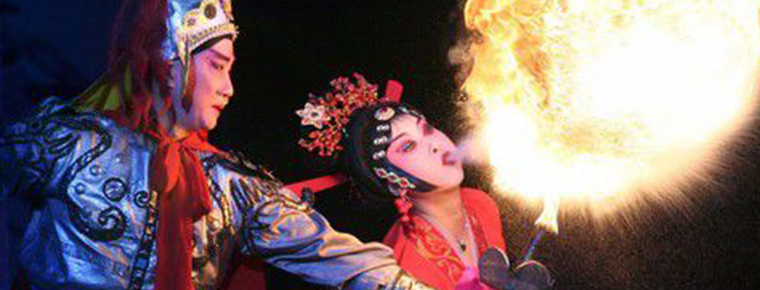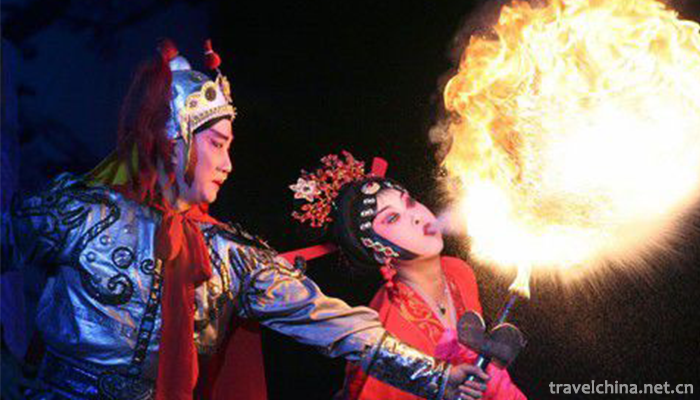2018-12-06

- By ChinaWiki.net
- Chinese Edition
- 2019-05-02
Two tones of Han tune
Originally known as "Shan Er-huang", "Tu Er-huang" or "Shan Er-huang", the second largest traditional opera in Shaanxi Province is one of the traditional local operas in southern Shaanxi Province. It is developed from folk songs, folk songs and minors in the Hanshui River basin. Its tone is pronounced in the middle of Han Dynasty, similar to that in Hubei Province. Being good at literary opera, Bashan has a strong flavor, elegant tone, graceful singing tone, soft Tao Bai, interesting language, delicate performance, simple and generous, strong singing tone and pronunciation of Baiba Mountain, and is good at Sichuan flavor. Plate style can be divided into upper and lower levels. Up-regulation is mostly used to express sadness, desolation and indignation; down-regulation is mostly used to express comfortable, bright and bold mood. Before the 1960s, Hantai District, Xixiang County, Zhenba County and other places in this city performed the second reed of HanDiao, but nowadays there is no such performance.
On May 20, 2006, the second reed of Han Diao was listed in the first batch of national intangible cultural heritage list with the approval of the State Council.
historical origin
The earliest birthplace of the second spring in the Han Diao is along the Haoping River in Ziyang. The earliest class activities can be traced back to the second year of Qianlong (1737). In 1958, according to old artists Feng Rencai and Qiu Shengmao, there was a wall inscribed on the musical building (stage) of Haoping Hedongmen Monastery: "Qian Sheng Ban broke the stage here in August of Qianlong 2002". Born in Qianlong 36 years ago, Art Artist Yang Lutai (Yang Family Genealogy) of Haoping River was famous for his performance in the area of Haoping River from the end of Qianlong to Jiaqing. During the period from Jiaqing to Daoguang, Yang Lutai and his son Yang Jinnian continued to lead the singing, and in Shaheba and Qujiahe of Xixiang, he founded the second reed class of Han Diao for the first time, with more than 60 apprentices. He trained two generations of artists for the second reed. The most outstanding artists of the "Lai" generation are Cha Lai Song and Qu Lai Shou, and the most outstanding artists of the "Hong" generation are He Hongsheng. The two generations of artists dispersed in Ankang, Hanzhong, Shangluo, Guanzhong and Sichuan, and continued to organize classes and teach apprentices, thus enabling the dissemination and development of the second reed of the Han Diao in various places. In the process of its popularity, influenced by the local languages, folk songs and local operas, Hanzhong, Ankang, Guanzhong and Shangzhen were formed one after another. In the late Qing Dynasty and early Republic of China, there were many classes and societies, and many artists came into being.
The second reed of the Han Diao originated in the middle and lower reaches of the Yangtze River. It was originated from the Siping Diao, which was introduced from Anhui to Hubei, and developed by Hubei artists. Xipi evolved from Shanshan and Shaanxi Bangzi introduced into Xiangyang area of Northwest Hubei Province. Some documents in the middle of the Qing Dynasty have recorded this. For example, in Yanlan Xiaopu, written by Wu Taichu in the fiftieth year of Qianlong (1785), it is recorded that Yaoqing, a famous actor, had "a new love song and Chu tune". Wang Xiangyun of Chuling is good at selling baboons, singing Jingjiang Yangge and Shahumian (Xueyang) Xiaoqu. In his Hankou Series Talks, Fan Kai of Qing Dynasty also recorded that Li Cuiguan and Li Rongqing, famous actors of Chu Diao in Hankou, were good at "Drunken Princess", "Pani Chasing Boat" and "Yutangchun".
The combination of the West skin and the two reeds is a process of gradual fusion over a long period of time. This integration has been recorded in Ye Tiaoyuan's Bamboo Branch Ci of Hankou published in Qingdaoguang's Thirty Years (1850): "The most desolate counter-tone in Quzhong is that the Western skin is slowly yellowing, and the voice needs to be round, bright and long under the upraised flat plate." "There are more than ten classes in Hankou, now there are three." The above description is Ye Tiaoyuan's experience when he visited Hankou again in Daoguang's thirteenth year. The book also describes the artistic inheritance relationship between the former actors and the actors at that time, saying, "Xiao Jin's name is fragrant on that day, and his throat is like a flutter of lips. For twenty years, it's Hulang who has been making a noise. From his account, we can see that as early as the end of Jiaqing, there were more than ten opera troupes singing Han tune in Hankou. They both sang Xipi and Erhuang. They had both positive and negative tones, and they were already a full-tuned opera. Therefore, the merging time of the Han tune and the Leather Spring in Hubei should be during the Jiaqing period.
During the reign of Jiaqing and Daoguang in the Qing Dynasty, Hubei Han Diao artists went to Beijing to take Hui classes such as Chuntai and Hechun to sing Pi-reed in Zhongzhou Yunhu Cantonese, which led to the appearance of "Class is Hui Class and Diao is Han Diao". According to the family tree of Mi Yingxian and Yu Sansheng, the Han Diao artists found in Hubei Province, it is proved that some Huibans in Beijing at that time took Han Diao artists as backbone. Mi Yingxian (1780-1832) was renowned as Beijing Teacher for his performance of Guanyu in "Battle against Changsha". Yu Sansheng (1802-1866), who came to Beijing in the early years of Daoguang, had been in charge of Chuntai Class, one of the four famous Hui Classes in Beijing for many years. At that time, Chun Tai Ban was also famous for its piquant and yellow tunes.
During the reign of Jiaqing and Daoguang in the Qing Dynasty, the economic prosperity of cities and towns in Hubei Province, the gathering of business and travel, the numerous temples and theatre buildings, and the rise of Han opera troupes and classes provided conditions for the prosperity and development of Han opera.
After Xianfeng in Qing Dynasty, influenced by the war, the second reed of Han Diao once declined. During Tongzhi and Guangxu years, after Hankou was established as a commercial port, famous actors and teachers from all walks of life in the Hanqu Dialogue gathered here again, and held three classes, Tian (Laotian Zi), Shuangxi and Xiyi, to cultivate a group of famous actors in the Hanqu Dialogue, which later became famous in the theatre circle. During this period, the number of Hanqu opera performers increased dramatically. Yu Hongyuan, Fu Xinyi and Chen Guoxin organized the Han Opera Association at this time. At most, the number of registered members was 7,000, and some of the artists in mobile class clubs were not included. From the late Qing Dynasty to the Republic of China, it was popular in Longdong, northern Sichuan, Yunnan, western Hubei and Western Henan. The period from Qingdaoguang to Guangxu was quite prosperous. In addition, he absorbed Kunqu opera, blowing tunes, high pluck tunes and other melodies, kneaded and blended local folk music, and sang in dialect, gradually forming his own style. Its aria is mainly composed of Xipi and Erhuang. Xipi comes from Xiangyang Tune, commonly known as Han Tune, which evolved from the Western Qin Opera. The second reed is traced from Anhui Province to the Hanshui River through Hubei Province, and it is called "the second reed of Han Diao" in conjunction with Xipi. After the Revolution of 1911, it was renamed Han Opera. In the period of the Great Revolution, Han Opera broke through the old rules, absorbed female artists to participate in performances, and organized a training society for young girls (also known as Xinhua Female Course) to cultivate a group of outstanding actresses represented by Xinhua Chai (Chen Bohua). During this period, the prosperity of Han Opera appeared again in Wuhan. Hanju performers have widely studied and exchanged with various operas, especially Peking Opera, which has improved and developed the performing arts of Hanju Opera.
Following the outbreak of the War of Resistance Against Japan, Erhuang artists of Han Opera responded to the call of the Communist Party of China and actively participated in anti-Japanese and national salvation activities. Under the leadership of Guo Moruo, Tian Han and Hong Shen, ten mobile propaganda teams of Han Opera were organized, led by Fu Xinyi, Wu Tianbao and Zhou Tiandong, to perform in Sichuan, Hunan and Western Hubei. It was only after the founding of the People's Republic of China that it once again had the opportunity to develop vigorously.
After the founding of New China, Ankang and Hanzhong were still called "Han Opera", while Shangluo and Guanzhong were still called "Erhuang". The second reed of Han Diao is popular in Ankang, Hanzhong, Shangluo and Guanzhong area centered on Xi'an. Since the founding of the People's Republic of China, Ankang Erhuang Opera Troupe has performed nearly 500 traditional plays, but this can not meet the needs of the audience. Therefore, they continue to transplant, collate and adapt historical plays, create new historical plays and modern plays, and enrich the repertoire. For example, more than 80 plays such as "Beijing 40 Days" and "Quyuan" were transplanted into the second spring of HanDiao, and more than 50 new ancient plays such as "Dalong Peng", "Liang Hongyu", "Banqiao Anecdote", "Zhao Cheng Selling" and modern plays such as "New Biography of Mei Dao", "Red Pearl", "Legend of Ma Dawei", "Long Ge of Loquat Village" were created. The performances of these new plays, first of all, are in harmony with the new era in terms of ideological content, which has a strong flavor of the times, thus arousing the interest of the audience, cultivating a group of new audiences and bringing new vitality to these ancient local operas. Especially in 1981, the first performance of Shaanxi Han Opera held by Shaanxi Cultural Department in Ankang was a grand event of Han Opera. More than ten professional theatre troupes participated in the performance in southern Shaanxi. Chen Bohua, a famous performer of Hubei Han Opera, also participated in the exchange show, which made the audience of Ankang see the unprecedented prosperity of the second reed in Han Diagram.

Ask a Question
Your email address will not be published.



0 Questions